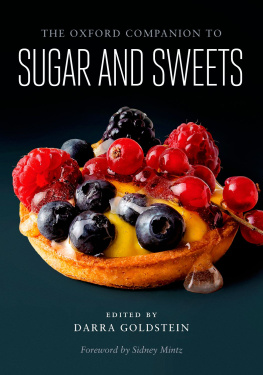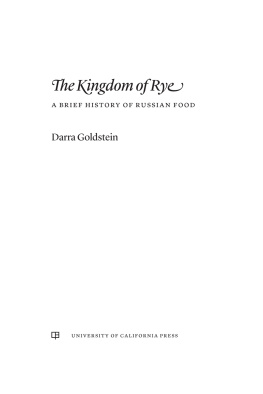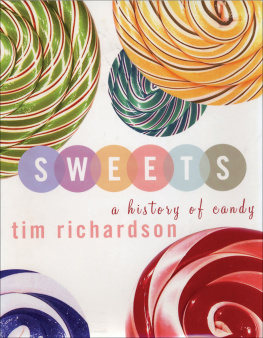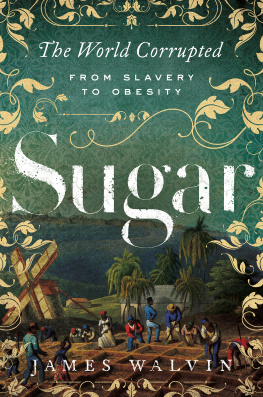How to search for terms in
The Oxford Companion to Sugar and Sweets
To find an entry in this e-book you can:
Browse the and select the entry you would like to view
or
Use your Search function to be taken to a complete list of references to your search term in the
CompanionIf your search term has its own entry, it will usually be listed at the top of your results
In cases where your search term appears in more than one entry heading, the results will be listed alphabetically
A note on special characters
While most e-readers can display special characters (such as and ), many cannot search for words containing them, unless the special characters themselves are typed into the search box. If you are unable to type these characters, please browse for your term using the .
Alphabetical List of Entries
CONTENTS
THE OXFORD COMPANION TO SUGAR AND SWEETS
| EDITORIAL BOARD |
editor in chief | Darra Goldstein Willcox and Harriet Adsit Professor of Russian, Williams College, and Founding Editor of Gastronomica: The Journal of Food and Culture, Williamstown, Massachusetts |
associate editor | Michael Krondl Author of Sweet Invention: A History of Dessert and The Donut: History, Recipes, and Lore from Boston to Berlin, New York, New York |
area editors | Ursula Heinzelmann Food and Wine Writer and Author of Beyond Bratwurst: A History of Food in Germany, Berlin, Germany |
Laura Mason Food Historian and Author of Sugar-Plums and Sherbet: The Prehistory of Sweets, Yorkshire, United Kingdom |
Jeri Quinzio Author of Food on the Rails: The Golden Era of Railroad Dining, Pudding: A Global History, and Of Sugar and Snow: A History of Ice Cream Making, Boston, Massachusetts |
Eric C. Rath Author of Food and Fantasy in Early Modern Japan, Professor, History Department, University of Kansas, Lawrence, Kansas |

Oxford University Press is a department of the University of Oxford. It furthers the Universitys objective of excellence in research, scholarship, and education by publishing worldwide.
Oxford New York Auckland Cape Town Dar es Salaam Hong Kong Karachi Kuala Lumpur Madrid Melbourne Mexico City Nairobi New Delhi Shanghai Taipei Toronto
With offices in Argentina Austria Brazil Chile Czech Republic France Greece Guatemala Hungary Italy Japan Poland Portugal Singapore South Korea Switzerland Thailand Turkey Ukraine Vietnam
Oxford is a registered trademark of Oxford University Press in the UK and certain other countries.
Published in the United States of America by Oxford University Press
198 Madison Avenue, New York, NY 10016
www.oup.com
Oxford University Press 2015
All rights reserved. No part of this publication may be reproduced, stored in a retrieval system, or transmitted, in any form or by any means, without the prior permission in writing of Oxford University Press, or as expressly permitted by law, by license, or under terms agreed with the appropriate reproduction rights organization. Inquiries concerning reproduction outside the scope of the above should be sent to the Rights Department, Oxford University Press, at the address above.
You must not circulate this work in any other form and you must impose this same condition on any acquirer.
Library of Congress Cataloging-in-Publication Data Goldstein, Darra.
The Oxford companion to sugar and sweets / edited by Darra Goldstein.
pages cm
Includes bibliographical references and index.
ISBN 9780199313396 (alk. paper)
ebook ISBN 9780199313624
1. SweetenersEncyclopedias. I. Title.
TP421.G65 2015
664'.1003dc23 2015000402
1 3 5 7 9 8 6 4 2
Printed in the United States of America on acid-free paper
I can remember easily the first time I stood deep in a field of sugarcane in full bloom, a field already marked for harvesting. It was the spring of 1948, and I had just begun fieldwork in Puerto Rico. The field lay in a rural barrio on the south coast of the island, only about a hundred yards inland from the beach. The well-irrigated soil in which the cane was growing was clayey, black in color. It looked cool under a blinding sun, but the air in the field was intensely hot.
The cane was the kind called gran cultura (literally, big growth), a term that means only that it was left to grow for 15 months or even more before being cut. Topped by the pale, wheat-like, lavender sugarcane blossoms they call guajana, the cane was thicker than a mans wrist. Standing more than 12 feet tall, these plants are bred to be one of the most substantial and important economic grasses in the world. They were full to bursting of their intensely sweet green sap, guarapo, which is drunk by the cupful nearly everywhere that cane is grown.
That sap is not won easily from the cane. Once it is cut and stripped of its leaves, it must be delivered to the mill as soon as possible to be crushed, ground, and soaked to extract its juice, before it begins to dry out or to sour. When freshly extracted, guarapo is definitely an acquired taste, even among sweet-crazed humans. Gray-green in color, lukewarm and cloying, and, if not strained, full of bits of cane fiber and other even less pleasant stuff, it also brims over with calories. The cane on a single acre of good tropical land can supply about 8 million calories. To get that many calories in wheat requires 9 to 12 acres. (And how many acres to get that many calories in beef? Dont even ask.)
There is a great deal aesthetically pleasing about sugarcane. Each stalk is a tiny living photosynthetic factory, transformed by human effort to maximize its yield. But the history of these beautiful grasses, and of the people who have looked after them during these last 2,000 years or so, is not so much beautiful as profoundly tragic.
After 30 years study of sugar and the countries that grow sugarcane and sugar beet and produce sugar in the New World, I started to write a book about it. I aimed to uncover the part that sugar played in world history during the first chapter of the economic system called capitalism. I knew something about the history of sugar. I realized that I would have to do what I could with this one thin thread, of sweetness and violence, embedded in the thick fabric of the past and stretching far back, long before anything like capitalism could even have been dreamed of. I found unexpected masses of data, much of it fascinating. What kept me afloat in a sea of alluring description was the simple hunch that sugarcane was not merely a dessert crop, as scholars of tea, coffee, chocolate, and sugar were wont to describe it. Far more than desserts, I thought, the history of sugars production and consumption might shed a bright light on the everyday unfolding of the capitalistic system.
Since it was linked for at least five centuries to the pain and suffering of millions of human beings, I have long thought of sugars sweet thread as red in colorthe color of blood. During the long struggle against the slave trade and slavery, blood was in fact the liquid the abolitionists came to invoke to depict the terrible work of men and women in chains: a teaspoonful of sugar for so many drops of blood.













